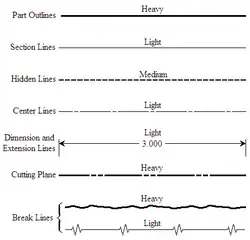Technical Drawing
This is a style guide for technical drawing, whether on paper or screen.
Title blocks
A title block should not exceed 170mm in width. Includes enough information to enable the drawing to be completely identified, and some additional and clarifying information. In no particular order:
- Title;
- Drawing number;
- Draughtsperson (Drafter);
- Checker;
- Approver;
- Scale (or not to scale - NTS);
- Dates;
- Sheet number;
- Revisions;
- Units (if other than millimeters);
- Disclaimers including copyright (of both the drawing and the design);
- Context such as company name, address, etc.
Also, some title blocks may include:
- Field for "Next Assembly";
- Field for "Used on";
- Third angle projection clarification;
- Reference number; and
- URL.
Line types
Line types are entities used on a drawing that have specific characteristics and meaning. The characteristics may be applied to lines and arcs.

Common line types include:
- Continuos / solid
- Center (center line)
- Hidden
- Phantom
Line widths
Standard widths: 0.13mm, 0.18mm, 0.25mm, 0.35mm, 0.50mm, 0.70mm. These are designed to be scaled to different ISO standard paper sizes and still be of a standard width (i.e. there is a multiplier of √2 between each).
| Use | Width | Example | SVG style guide |
|---|---|---|---|
| Page & title box borders | 0.70mm | stroke-width:0.70mm; stroke-linejoin:bevel | |
| General Outlines | 0.35mm | stroke-width:0.35mm; stroke-linejoin:miter | |
| Hidden Outlines | 0.35mm | stroke-width:0.35mm; stroke-linejoin:miter; stroke-dasharray:7,2 | |
Note: Line width is different than line weight.
Representation of materials
Materials are represented by hatch patterns. The patterns are classified under ISO or ANSI guidelines, though other predefined patterns may be used; for instance, ANSI38 is used to denote aluminum. The hatch pattern can only tell what type of material in general form, that is, it does not indicate the specific composition.
Brickwork
Brickwork in section is represented by parallel 0.35mm lines, outlining the actual (i.e. scaled) width of the brickwork, with double 0.25mm lines crossing at 45˚, spaced three line-thicknesses apart and such that one pair starts 1/3 of the wall thickness from where the previous pair met the opposite line.